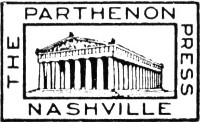
The Parthenon at Athens, Greece
and
at Nashville, Tennessee
Excerpts
from
The Parthenon of Pericles
and Its
Reproduction in America
Illustrated
By
Benjamin Franklin Wilson, III
Director of the Parthenon

PARTHENON PRESS
NASHVILLE
THE PARTHENON AT ATHENS, GREECE
And
AT NASHVILLE, TENNESSEE
(Excerpts from THE PARTHENON OF PERICLES AND
ITS REPRODUCTION IN AMERICA)
Copyright, MCMXLI
By Benjamin Franklin Wilson III
TO
THE MEMBERS OF THE BOARD OF PARK COMMISSIONERS
1920-1941
- R. M. Dudley
- M. T. Bryan
- Lee J. Loventhal
- W. R. Cole
- R. T. Creighton
- Chas. M. McCabe
- Percy Warner
- Rogers Caldwell
- J. P. W. Brown
- Edwin Warner
- C. A. Craig
- Jas. G. Stahlman
- Vernon Tupper
- Bascom F. Jones
Whose intelligent and untiring interest made possible thereproduction of the Parthenon at Nashville; in memoryof those who are gone, and in appreciation of thosewho are living, this booklet is gratefully dedicated
Background
The Parthenon of Pericles, while not thought to beone of the wonders of the world, nevertheless has alwaysbeen regarded as one of the most wondrously beautifuland inspiring of the world’s buildings. It embracesthe best effort of the mind, the heart, and thehand of man. In it are bound up the religion, the history,and the art of Greece.
It has been well said that art is organized emotion,while science is organized knowledge. The field of emotionfound its first great development among the Greeksand in the time of Pericles reached its zenith. Assuredlythe Greeks have never been excelled in the beauty oftheir architecture or sculptural art.
The influence of religion was dominant in the lifeand thought that produced such outstanding men inthis period of world history as Phidias and Sophocles,Ictinos and Pericles. Every function of the mind, everyactivity of the hand, was closely associated with somegod or goddess, and to this inspirational incentive theworld is greatly indebted for the Parthenon. Themythological stories of the Parthenon largely cover themythology of Greece. Twenty-eight of the major deitiesand numerous minor deities and personifications adornits pediments.
At the time of its destruction in the seventeenth century,a little more than two thousand years after itscompletion, the Parthenon was almost in as good conditionas it was at its beginning. The changes made by theChrist